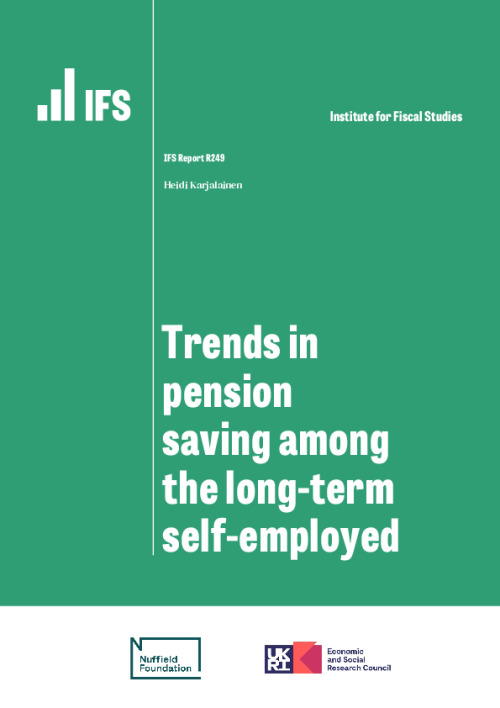The number of self-employed workers has been rising rapidly in the UK in recent decades. At the same time, private pension participation among this group has fallen sharply, leading to increasing concern among policymakers about the preparedness for retirement of self-employed workers. This report documents and analyses private pension saving using administrative data that follows the UK self-employed population over the decade from 2005–06 to 2014–15.
We focus on a particular subset of the self-employed population, namely the working-age long-term self-employed (defined as those aged 22–64 who have been self-employed with no employment income for at least 5 years). We use a data set of Self Assessment tax returns, which self-employed workers have to submit each year to HM Revenue and Customs. We first document how the characteristics of the working-age long-term self-employed have changed over this period. We then focus on trends in pension participation and contribution amounts for this group of workers.
Key findings
1. Incomes of the working-age long-term self-employed fell significantly over the decade from 2005–06 to 2014–15. Median earnings decreased from £17,850 to £12,640 per year (in 2015–16 prices), equivalent to a 29% decrease. The distribution of self-employment incomes is less unequal after the financial crisis than before due to top incomes falling by more than the bottom incomes.
2. The self-employed tend to have more volatile incomes than employees. With administrative tax data, we can follow self-employed individuals over time and measure their year-to-year income volatility. The volatility of self-employed incomes (as measured by the coefficient of variation of annual income) increased slightly between 2006–07 (where the data are unaffected by the Great Recession) and 2011–12 (where the previous 5 years include the Great Recession and its immediate aftermath), but returned to pre-financial crisis levels by 2014–15.
3. Private pension participation among the self-employed fell dramatically between 2005–06 and 2014–15. Among the working-age long-term self-employed, the private pension participation rate fell from 33% in 2005–06 to just 14% in 2014–15. Participation rates were even lower among those who had been self-employed for less than 5 years – the private pension participation rate among all working-age self-employed individuals with no employment income fell from 26% to 11% over this period.
4. Private pension participation rates among the long-term working-age self-employed fell across men and women and all income, age and industry groups. For example, private pension participation rates in the construction sector (which is the most common single industry among the self-employed) fell from 38% to 12% between 2005–06 and 2014–15.
5. Lower incomes and higher income volatility have been offered as plausible explanations for lower rates of saving into illiquid pension assets among the self-employed. We find that pension participation is higher among those with higher income (both from self-employment and other sources), those with less volatile income (as measured by the coefficient of variation of annual income), and among those having a good income year (income in the current year being higher than the 5-year average). However, these effects are economically small – for example, an increase of £1,000 in self-employment earnings is associated with only a 0.5 percentage point increase in pension participation.
6.The changing composition of the self-employed population explains only about a third of the decline in pension participation between 2005–06 and 2014–15, even after including a wide range of individual characteristics such as income and income volatility measures in the analysis. Therefore the majority of the decline in private pension participation among the self-employed cannot be explained by changes in the characteristics of the self-employed population that are observed in tax data.
7.Among those of the working-age long-term self-employed who were saving into a pension, average (mean) annual pension contributions increased over time, from £4,390 to £5,810 (in 2015–16 prices) or from 10% to 12% of total income. However, median contributions remained stable, implying that most of the increase in contributions took place at the top of the distribution of contributions. Perhaps surprisingly, the changing composition of the self-employed does not appear to be a driving force behind this change: the time trends of contributions are very similar for the sample of the self-employed who were saving into a pension consistently throughout the sample period.










